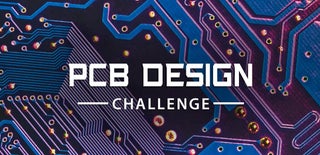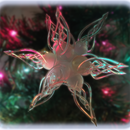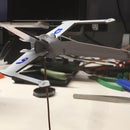Introduction: MOSTER FET - Dual 500Amp 40 Volt MOSFET 3d Printer Heated Bed Drivers
You probably clicked on this thinking holy cow, 500 AMPS!!!!!. To be honest, the MOSFET board I designed will not be able to safely do 500Amps. It might for a short bit, just before it excitedly burst into flames.
This was not designed to be a clever trick. It was NOT my evil plan to lure you into my instructable (insert mad scientist laugh here). I wanted to make a point. The advertising for 3D printers and their components can be very misleading. Especially in the low cost DIY market.
I'm going to explore just one case of this. A common MOSFET board which is used to protect the 3d printer main board from damage. They are also used to upgrade a pinter to a more powerful headed bed. Generally with more print area.
There are half dozen different designs out on the market. Most have these giant heatsinks and look very impressive. But most of that is a gimmick.
While we analyze one of these boards; I am going to design my own. After looking at what's on the market, I decided I could do better. So, I am going to design an Open source, Open Capabilities board that and does the job exceedingly well.
The design I am targeting is a 40v 60Amp dual MOSFET board. Not 1 channel but 2. One for the heated bed and one for the hotend. There is a story behind the design. For those of you who don't care about the story behind the board, you can go straight to the source files for the board.
Supplies
All the footprints for this board design are hand soldered.
Tools:
- Tweezers
- Soldering iron
- Solder
- Snips for Electronics
BOM:
| References | Supplier Part No | Supplier | Value | Quantity |
| C11, C21 | CL21B103KBANNND-ND | Digi-Key | 10000pF | 2 |
| R11, R21 | 311-1.00KFRCT-ND | Digi-Key | 1.0K | 2 |
| R15, R25 | 311-3.60KFRCT-ND | Digi-Key | 3.6K | 2 |
| R13, R23 | RMCF1210JT2K00TR-ND | Digi-Key | 1.99K | 2 |
| D11, D21 | BZX84C15LT3GOSTR-ND | Digi-Key | 15V | 2 |
| U11, U21 | TLP182(BL-TPLECT-ND | Digi-Key | TLP182 | 2 |
| CN11, CN21 | 277-1667-ND | Digi-Key | 2 | |
| Q11, Q21 | AUIRFSA8409-7P-ND | Digi-Key | AUIRFSA8409-7P | 2 |
| J11, J21 | PRT-10474 | Spark Fun | XT-60-M | 2 |
| J12, J22 | PRT-10474 | Spark Fun | XT-60-F | 2 |
| JUMPERS | 10 AWG solid core wire |
Step 1: How You Are Given the Facts But Does Not Represent What You Are Purchasing
The MOSFET board in that picture is very common. You can find it on eBay, Ali Express, Amazon and loads of other places. It's also very inexpensive. For 2 you could pay as little as $5.00.
The Headline usually is "210 Amp MOSFET". It is true that the MOSFET is a 210 amp MOSFET. However, the entire product can only do 25 Amps. The limiting factor is the PCB and the connector.
As we'll see later, The PCB probably limits the design even more. The copper traces don't look very thick.
So they told you the truth about the MOSFET but not about the entire product.
There's also a lot of marketing going on here. See that giant heatsink. Most people think wow that must be a pretty powerful part. The truth is, if that part NEEDS that heatsink the MOSFET is wasting a lot of energy. That energy could have gone into heating the print bed. A large heat sink is not a good sign. But it is what we expect to see on high power devices. The best I can tell this part is just for marketing, at least at 25 Amps.
I want to design a product that does it's job well, is good quality, low cost, and is very straight forward about its capabilities.
Step 2: The Core of the Circuit: the MOSFET
I want the design to be very efficient. That would mean low power loss across the device. So resistance is my enemy. MOSFETs act like a voltage controlled resistor. So when they're off, their resistance is very large. When they're on, their resistance is very low. There's actually a lot more going on than that. However, for our discussion it'll be good enough.
The parameter we should pay attention to on MOSFET data sheet is "RDS on".
The MOSFET I selected was the AUIRFSA8409-7P made by Infineon Technologies. It's worst case RDSon is 690u Ohms. Yep, that was correct micro ohms. But the part is expensive. Around $6.00. for one. The rest of the design will be very inexpensive components. Having a good design means picking a good MOSFET. So, if we are going to splurge this is the area to splurge in.
Here is a link to the Data Sheet
Notice this part is 523Amp MOSFET. However, the Id current is limited to 360Amps. The reason is two fold.
- The part package can't dissipate enough heat to sustain 523 amps.
- They don't have enough bonding wires on the die for 625Amps. Thus "Bonding limited"
I'm going to limit the design to 60Amps. The resistance is low so I will get some really great efficiency in a small area.
The part is going to be dissipating about 1.8Watts at the max current drawn. (R x I^2) The thermal resistance for this part is 40 deg C/Watt. (click here to understand what calculations are being done). So at max current draw we will be at 72 deg above ambient. The data sheet specifies max temperature for the device is 175 deg C. We are well under that list. However, if we account for an ambient temp of 25deg C. Then we are just under 100 deg C. We are going to need a small heat sink and a fan at full load.
All this assumes we have 15v at the gate. Once we drop below 10v, we really start having heating issues.
The efficiency will be (assuming 40v) 2400 watts delivered, 1.8Watts wasted. About 99.92%.
| Power Supply | Delivered | Lost | Efficiency |
| 40 | 2400 | 1.8 | 99.92% |
| 24 | 1440 | 1.8 | 99.87% |
| 12 | 720 | 1.8 | 99.75% |
| 10 | 600 | 1.8 | 99.40% |
So our example product had a 220Amp MOSFET. I have a 523Amp MOSFET and the silly thing is still getting hot. My point here is that the specified current is not a great indicator of the performance. A better specification would be the total on resistance of the board and the MOSFET. This one specification gives you almost everything you need to know.
Step 3: Other Key Components
Typically, the MOSFET board uses the heated bed output of the printer as its control signal. U11 is a bidirectional optocoupler. This part has several purposes.
1) You can't mis-wire the input. This is a little bit of dummy proofing. The main board will either sink current or not. So the input trigger is based on whether or not we have current flow between the control board heated bed pins.
2) Isolate the high power side from the low power control board. This will allow you to use a higher voltage on the heated bed. For example you can have a 12 volt control board and a 24 volt heated bed. The grounds don't need to be connected (completely isolated). You have a whopping 3750 Vrms of isolation.
3) Remotely control the heated bed. The power supply, heated bed, and MOSFET board can be in a completely different section of the printer from the control board. The control lines are based on current flow so noise is not an issue. The board could be quite some distance from the control board. Heavy power wires are expensive. Having all the high power stuff in one spot makes a lot of sense.
4) I can over drive the gate of the MOSFET and lower the RDSon resistance even more. But I can't exceed 20 volts or the MOSFET dies. That is what the Ziner (D11) is for; to clamp the gate to 15v.
One last important component is R12. This is a bleed off resistor. The gate of the FET has a capacitor on it. All MOSFETS do. The more powerful the MOSFET, the bigger the capacitance is. As a rule of thumb. So when U11 turns off we need to discharge that gate capisistor. Otherwise we will get a very slow turn off time. In addition to all that, U11 has a little bit of leakage. If R12 was missing, the gate cap would charge up and the gate would exceed Vgsth and the MOSFET would turn on. This keeps the gate pulled down.
Step 4: The Board Design - It Is One of the Most Important Design Points
Ok, now on to PCB design.
Lets start with some of the simple decisions. What to call it and what color it should be. Yes, marketing. People like things that look nice. Technical stuff should have clean lines and look, well, technical. The other thing is that color is important. People seem to associate powerful dangerous stuff with the color black. Think swat team verse the local police. Both have authority. But quite frankly I would rather be pulled over by my local cop than a swat team. So the color is black.
Now what to call it. Because 60 Amps is a monstrously large MOSFET, I thought I would call it MOSTER FET. Ok I know it's corny. But, dammit Jim I'm an engineer not a marketing professional. I even made a cool logo. Again, I'm not a marketing professional.
The next most important decision for the circuit board is copper thickness. The circuit board traces must carry the full load of 60 Amps. So there are several things we can do to make that happen. Short trace lengths, wide widths, and thick copper. All these things reduce trace resistance.
Printed circuit board copper thickness is specified in ounces. So 1 ounce copper weighs 1 ounce per 1 square foot. So, 4 ounce copper would be 4 times thicker. It would also carry 4 times the current. After doing some analysis, I discovered that the cost does not go up linearly with copper thickness. I use PCBWAY's (here) quick quote to determine board cost. (that is one of those kick back links, helps keep making boards) If I was building thousands of boards, the cost curve would flatten out. But I'm not.
| Copper thickness | Cost for 10 | PCB Size |
| 1oz | $23.00 | 50mm x 60mm |
| 2oz | $50.00 | |
| 3oz | $205.00 | |
| 4oz | $207.00 | |
| 5oz | $208.00 | |
| 6oz | $306.00 | |
| 7oz | $347.00 | |
| 8oz | $422.00 |
There is also a problem with think copper boards. The thicker the copper, the longer it takes to etch and the more detail you loose. Basically this means the trace spacing must be really wide. It also means that the minium trace width is fairly large. In this design, I can afford that. I want to fit two channels in the same space that previously held one. So 1oz copper it is.
However that's going to cause a another problem. 1 ounce copper will not carry the load. My board will be a spectacularly expensive fuse.
There are only three traces per channel that need to have a heavy current load. As you can see in the picture, I have removed the solder mask on six traces. My plan is too solder 12AWG solid core wire on those traces. Normally this would not be a great plan. However, board cost is out weighing the cost of the extra components. Not to mention that the copper wire will need to be custom cut and formed; making mass production manufacturing difficult. In short, I will neither become famous or rich.
This is where our example board may have another issue. The copper thickness on that board is very thin. The traces are wide. But at some point that does not help anymore. All the current comes from a single pin to a single pin. The wider traces allow for better cooling but you're still going to have some hot spots.
My plan is to use all surface mount parts except for the connectors. Surface mount connectors get ripped off of the board too easily. I am also going to use TX60 connectors for power and the heated bed. They are used in the RC world. They are inexpensive and carry the load. However, they are solder cup connectors. The cups will have to be filled with solder to meet spec. The ender series printers use these connectors for their heated beds. So this is a really good choice.
The other connectors I am going to use are 5mm screw terminals. They are inexpensive and work well in this kind of application.
The small heatsink needed for the MOSFET is integrated into the circuit board. This is both a good idea and a bad one. It's good for cost; however, if the part gets too hot, the board will delaminate. You really need to be very hot for a long time for this to happen. For extreme temperatures an aluminum heatsink would be much better. Most likely, if the board is running 60 Amps, a fan will need to be used. That is why the heatsink holes are a bit larger. To let air pass through the board. I have done this before and it works incredibly well. But is raises board costs a bit. But it is still less cost then an aluminum heat sink.
Lastly, each channel is independent. The grounds and the power lines are not connected, even though, in the schematic they have the same net name. This way your control board could be at 12v, the Heated bed at 24v, and the to hotend at 12v. It gives you options.
Step 5: Building the Board
I am using KiCad. There is a plugin for it that creates a interactive BOM. Just highlight line in the BOM and it hi lights the places it goes. It is my favorite plug-in for KiCad The plugin generates a self contained HTML file. (HERE). So the file is portable. I use it on my tablet device (or phone) when I am building boards.
I got the boards just a short time ago. As you can see this version looks a bit different from the other sections. The boards I built where prototypes (pictured below). All the design feedback I got durning testing went back into the design. If you also notice R12 and R22 are missing. I forgot to add a bleed off resistor. Big mistake. Had some odd operation for a bit until I saw what was missing. Then I had to "dead bug" them on.
The board design file in the git repository are the latest version and have all the bug fixes.
But here it is; in all it's glory. (insert Angels singing sound effect)

Step 6: In Operation - the Proof of the Pudding Is in the Eating.
I started testing the boards. So the first thing I noticed is the LED shines like the sun. Ya I get it the LED does not need to be that bright. But when it is deep inside your printer you will thank me. Unless of course you have an Anet A8. If that is the case, just ware some sun glasses like I did.
I could probably just change R15 and R25. But the wide range of supply (10v-40v) voltages make me hesitate.
I have a 29V 25Amp Supply. I adjusted my 24v Meanwell power supply to 29v. I also have a 400mm Round heated bed that is 400Watts at 24v. At 29 Volts we will draw exactly 20 AMPS. So 20 Amps is the best Im going to get.
The measurement was taken from the negative side of J11 and J12. Basically across the MOSFET. But it was done at the connectors. Where the wires plug in. The board dropped 23mVolts at 20Amps. That would put the total device resistance at 1.15mOhms. That is the MOSFET, Board, and Connectors. That is really good if I do says so myself. (and there was much jubilation)
Step 7: The Side by Side
OK, in the end I would like to say my Board wins. It has everything you could want. Here is the comparison. However, the cost to build this guy is just too high.
| Spec | Common MOSFET | MOSTER FET |
| Max Voltage | Unknown | 40V |
| Max Curent | 25 Amps | 60 Amps |
| Reversible Trigger | Yes | Yes |
| Opto isolated | Maybe | Yes |
| Cost (2 Channels) | $12.99 | $14.99 |
| Channels | 1 | 2 |
I am going to pretend that I can build thousands of these.
If you are going to make a business of selling 3d printer parts, you need to have a profit margin of 40% or more. It would be better if it was much higher, but that is the minimum you need to stay afloat. I assumed a $3.50 BOM cost and $3.76 manufacture cost. I had the board quoted at a few local places. If you sell on Amazon or E-bay then they wack you 30% in credit card fees, PayPal fees, and Sales fees. Trust me, it works out to 30%. They will tell you different but all said and done I get 70% of whatever was sold.
This board does need to be at $15.99 to truly be viable. However the DIY market is very sensitive to price. So set it to $14.99. You can always upsell on mounting brackets or wiring kits.
The other thing that you see here is that the common board is heavily marketed. Lots of DIY videos which you can find anywhere. The DIY market wants to know it works and how to use it. Only about 10% of that market try something new or are first adopters. Only about 3% of those publish any data or do a "HOW TO" video. In short the likelihood of selling 10K pieces in a year is very small.
The most this would sell is about 100 per year, if your good at it. The price point at that level is 24.99. The BOM alone is $13.00.
In short, not a viable product. If I could get the MOSFET down in price range of $0.75 - $1.00 it might work.
But it was fun to make. I think it is a better design, but then again I did it.
Enjoy the board!!! (HERE)
Update:
I did find a MOSFET that is capable for under $1.00 If you want a fully constructed board I have them on e-bay. (HERE) or the Sigle channel version (HERE)

Participated in the
PCB Design Challenge













